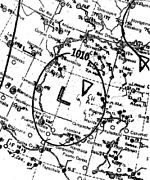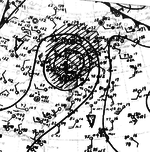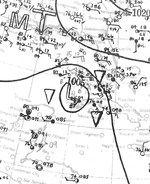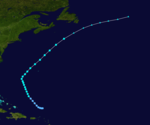1933 Atlantic hurricane season
| 1933 Atlantic hurricane season |
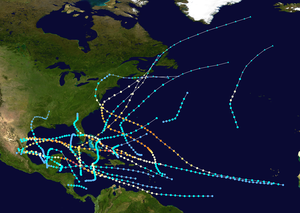
Season summary map
|
| Seasonal boundaries |
| First system formed |
May 14, 1933 |
| Last system dissipated |
November 17, 1933 |
| Strongest storm |
|
| Name |
"Tampico" |
| • Maximum winds |
160 mph (260 km/h) |
| • Lowest pressure |
929 mbar (hPa; 27.43 inHg) |
| Seasonal statistics |
| Total storms |
20 |
| Hurricanes |
11 |
Major hurricanes
(Cat. 3+) |
6 |
| Total fatalities |
651 |
| Total damage |
$86.6 million (1933 USD) |
|
|
Atlantic hurricane seasons
1931, 1932, 1933, 1934, 1935
|
| Tropical storm (SSHWS) |
|
|
| Duration |
May 14 – May 19 |
| Peak intensity |
50 mph (85 km/h) (1-min) 1001 mbar (hPa) |
| Category 2 hurricane (SSHWS) |
|
|
| Duration |
June 24 – July 8 |
| Peak intensity |
110 mph (175 km/h) (1-min) ≤ 965 mbar (hPa) |
| Tropical storm (SSHWS) |
|
|
| Duration |
July 14 – July 23 |
| Peak intensity |
50 mph (85 km/h) (1-min) 999 mbar (hPa) |
| Tropical storm (SSHWS) |
|
|
| Duration |
July 24 – July 27 |
| Peak intensity |
60 mph (95 km/h) (1-min) 1008 mbar (hPa) |
| Category 1 hurricane (SSHWS) |
|
|
| Duration |
July 24 – August 5 |
| Peak intensity |
90 mph (150 km/h) (1-min) 975 mbar (hPa) |
| Category 4 hurricane (SSHWS) |
|
|
| Duration |
August 13 – August 25 |
| Peak intensity |
140 mph (220 km/h) (1-min) < 940 mbar (hPa) |
| Tropical storm (SSHWS) |
|
|
| Duration |
August 14 – August 21 |
| Peak intensity |
45 mph (75 km/h) (1-min) 1007 mbar (hPa) |
| Category 5 hurricane (SSHWS) |
|
|
| Duration |
August 22 – September 5 |
| Peak intensity |
160 mph (260 km/h) (1-min) < 930 mbar (hPa) |
| Tropical storm (SSHWS) |
|
|
| Duration |
August 23 – August 30 |
| Peak intensity |
50 mph (85 km/h) (1-min) 999 mbar (hPa) |
The 1933 Atlantic hurricane season was the second most active Atlantic hurricane season on record, with 20 storms forming in the northwest Atlantic Ocean. The season ran through the summer and the first half of fall in 1933, with activity as early as May and as late as November. A tropical cyclone was active for all but 13 days from June 28 to October 7. The year was surpassed in total number of tropical cyclones by the 2005 season, which broke the record with 28 storms. Tropical cyclones that did not approach populated areas or shipping lanes, especially if they were relatively weak and of short duration, may have remained undetected. Because technologies such as satellite monitoring were not available until the 1960s, historical data on tropical cyclones from this period are often not reliable. Compensating for the lack of comprehensive observation, one hurricane researcher estimates the season could have produced 24 tropical cyclones.
Of the 20 storms during the season, 11 attained hurricane status. Six of those were major hurricanes, with sustained winds of over 111 mph (179 km/h). Two of the hurricanes reached winds of 160 mph (260 km/h), which is a Category 5–the highest of 5– on the modern Saffir-Simpson Hurricane Scale. The season produced several deadly storms, with eight storms killing more than 20 people. All but 3 of the 20 known storms affected land at some point during their durations.
The 1933 season was the most active of its time, surpassing the previous record-holder of 19 storms in 1887. Fifteen of the season's storms made landfall as tropical cyclones, and another struck land as an extratropical storm. Eight tropical storms, including six hurricanes, hit the United States during the season, including the Chesapeake–Potomac hurricane, which the U.S. Weather Bureau described as one of the most severe in history along the Mid-Atlantic States. Seven tropical storms, including four hurricanes, hit Mexico, two of which caused severe damage in the Tampico area.
...
Wikipedia




